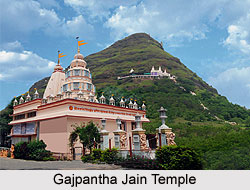 Teerthraj Gajpantha Jain Temple is one of the popular Jain pilgrimage centers. It is located at Mhasrul. It is almost 5 kms from Nashik City. Gajpantha is positioned on the Nashik Gujarath road. Teerthraj Gajpantha is situated on top of a 400 ft tall hill that offers a panoramic view of the scenic beauty that surrounds it. Visitors need to climb 435 staircases to reach the temple premises. The temple is built in black stones.
Teerthraj Gajpantha Jain Temple is one of the popular Jain pilgrimage centers. It is located at Mhasrul. It is almost 5 kms from Nashik City. Gajpantha is positioned on the Nashik Gujarath road. Teerthraj Gajpantha is situated on top of a 400 ft tall hill that offers a panoramic view of the scenic beauty that surrounds it. Visitors need to climb 435 staircases to reach the temple premises. The temple is built in black stones.
History of Gajpantha Jain Temple
Teerthraj Gajpantha is regarded to be very auspicious for the followers of Jainism. It is believed that seven Balbhadra (saints) of Jain Sect known as Vijay, Achal, Sudharma, Suprabh, Nandi, Nandimitra and Sudarshan had attained nirvana here. Along with them they also paved the path of Moksha for eight crores of Yadav Kings.
Gajapantha Teerth houses a caravanserai, a small hut that is located at the foot of the hill as well as a temple at the top of the Gajadhwaja Hillock. The famous Chamber Caves are also situated here. According to the ancient holy book "Shantinath Purana" it was under the instruction of Mysore`s Chamaraj King that the statues of saints in the temple were installed in 600 B.C. The caves are thus named as "Chamer Caves" or "Chambhar Caves". According to ancient literature there is a reference of the vicinity of Anjangiri hillock near Gajadhwaja.
The Temple of Gajpantha
The temple of Gajapantha is beautifully decorated and artistically designed. Devotes visiting the temple can see the Shweta Charan of Sudarshan, Nandi and Nandimitra Balabhadras. Going further down the temple the Shweta Charan of Suprab, Sudharma, Gajkumar, Achal and Vijay Balbhadra can also be seen. During an excavation a beautiful sculpture of Bhagwan Parshvanatha was found here. The statue is almost 194 inches tall and is grey in colour. With the help of Seth Shobharam Bhagwandas from Pune the statue of Parshvanatha was reinstalled here. There are two cave temples located in the vicinity of the temple.
The temple of Gajapantha directs to a staircase that leads to the Gajadhwaja Hillock. At the end of this hill a beautiful garden and the Samadhi (shrine) of Kshemendra Kirti is located. A temple has also been constructed here that is dedicated to Lord Mahavira. Here the statue of Lord Mahavira faces four directions. About 16 kms away from Gajpantha there is a hill in Anjaneri area. Two beautiful caves are situated on this hill. One of the caves houses engravings of Lord Mallinath. These idols are almost 3 feet in height and are seated in Padmasana posture. The other cave has five idols. A shell inscription dating back to 12th century has been located in the foothill temple. According to the inscription it had a five feet idol of a Jain Tirthankara.
Apart from the temples of Gajapantha there are many other temples located here. There is an old caravansary or Dharmashala located in the north direction of Mhasrul village. The caravansary is enclosed by a fortification. A 100 years old Jain Chaityalaya temple is also located here. The temple houses idols of Jain Tirthankaras. The idol of Lord Mahavira is installed here. The idol is seated in a Padmasana posture and is 25 inches tall. To the left of this statue of Mahavira another statue of Lord Adinath has been installed. The statue of Adinath is also in Padmasana posture. There are 31 other idols in the temple that includes seven Balbhadras and one Gajkumar statue. In the vicinity of the temple there is a Saraswati temple and a Mehta Dharmshala made at the request of Bhattarak Kshemendra Kirti. A big tower has also been built in front of the Jain Chaityalaya. The tower houses four sculptures of Lord Mahavira.
An annual gathering is organized here every year. It is held on the14th day of Magha to celebrate the ceremonies of Jalayatra and Gajaratha.




















